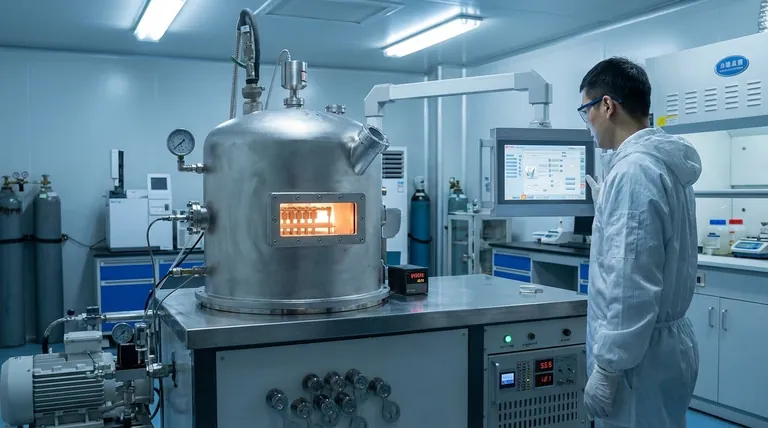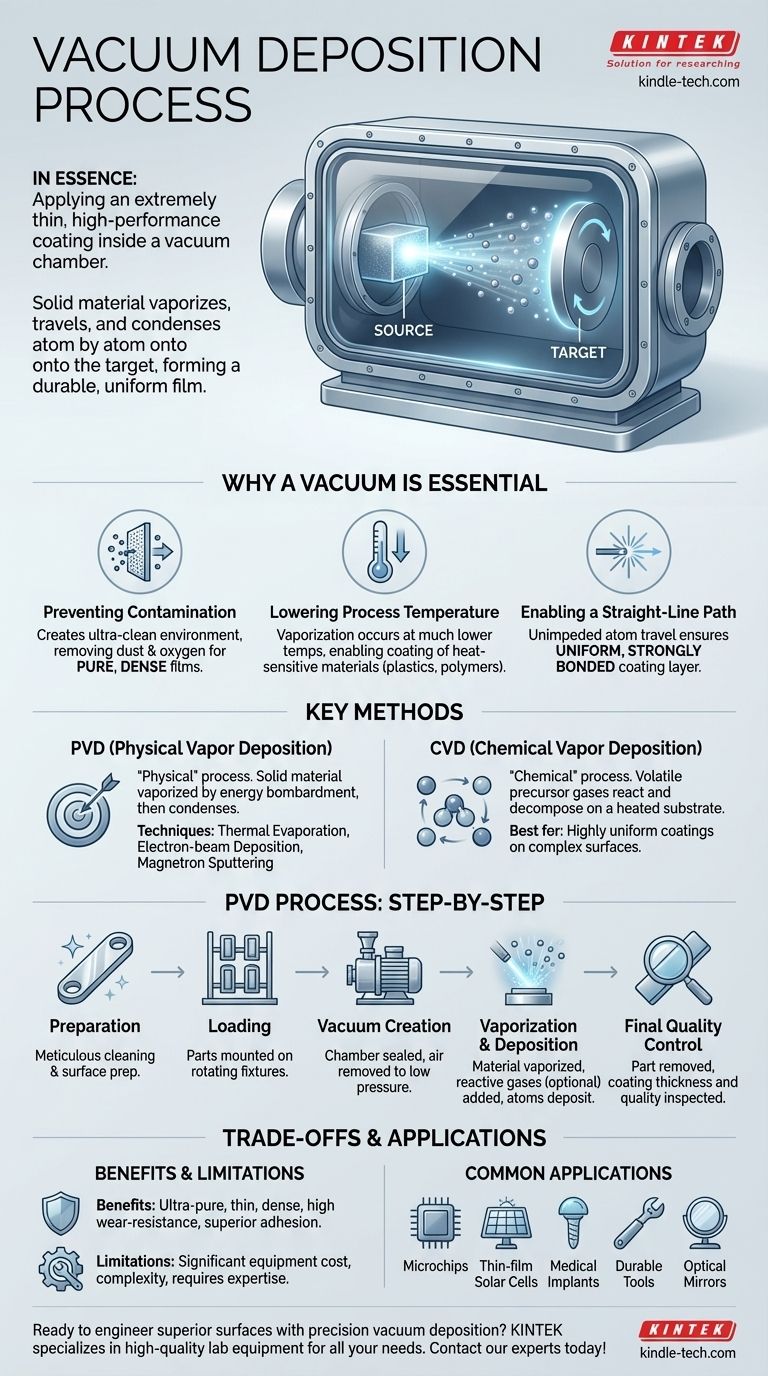In essence, vacuum deposition is a process for applying an extremely thin, high-performance coating onto a surface inside a vacuum chamber. A solid coating material, such as a metal like titanium or chromium, is vaporized. This vapor then travels through the vacuum and condenses, atom by atom, onto the target object, forming a durable and uniform film.
The critical insight is that the vacuum itself is not just an empty space; it is the active ingredient. By removing air and other contaminants, the vacuum enables a level of purity, control, and adhesion that would be impossible to achieve in a normal atmospheric environment.

Why a Vacuum is Essential
Operating within a vacuum is fundamental to the entire process. It fundamentally changes the physics of how the coating is created and applied, leading to superior results.
Preventing Contamination
The primary role of the vacuum is to create an ultra-clean environment. Pumping out the air removes particles like dust, oxygen, and water vapor that would otherwise react with the vaporized coating material or contaminate the target surface.
This ensures the final film is exceptionally pure and dense.
Lowering the Process Temperature
Just as water boils at a lower temperature at high altitudes, materials vaporize at much lower temperatures in a vacuum.
This allows for the successful coating of heat-sensitive materials, including plastics and polymers, which would warp or melt under higher-temperature conditions.
Enabling a Straight-Line Path
In the near-total absence of air molecules, the vaporized coating atoms can travel in a straight, unimpeded line from their source to the substrate.
This "line-of-sight" travel is crucial for creating a uniform and strongly bonded coating layer.
Key Methods of Vacuum Deposition
While the core principle is the same, there are two primary families of vacuum deposition, distinguished by how the coating material is delivered to the surface.
Physical Vapor Deposition (PVD)
PVD is a "physical" process. A solid material (called a "target") is bombarded with energy, causing it to vaporize. This vapor then physically travels and condenses on the substrate.
Common PVD techniques include thermal evaporation (heating the material), electron-beam deposition, and magnetron sputtering (using ion bombardment from a plasma).
Chemical Vapor Deposition (CVD)
CVD is a "chemical" process. Instead of vaporizing a solid, one or more volatile precursor gases are introduced into the vacuum chamber.
These gases undergo a chemical reaction and decompose on a heated substrate, forming the desired solid film. CVD is particularly effective for creating highly uniform coatings over large or complex surfaces.
A Step-by-Step Look at the PVD Process
To make the concept more concrete, the PVD process typically follows a precise sequence of events.
Preparation and Cleaning
The process begins long before the part enters the chamber. The substrate must be meticulously cleaned, which may involve stripping old coatings or residues. Any imperfection on the surface will be an imperfection in the final coating.
Loading and Fixturing
Parts are carefully mounted on specialized racks inside the chamber. This fixturing is designed to rotate the parts during the process, ensuring all critical surfaces are evenly exposed to the vapor source.
Creating the Vacuum
The chamber is sealed, and a series of powerful pumps remove the air, reducing the internal pressure to a fraction of the Earth's atmosphere.
Vaporization and Deposition
Once the vacuum is established, the coating process begins. The solid target material is vaporized. At the same time, reactive gases like nitrogen or argon can be precisely introduced to the chamber.
These gases react with the metal vapor to form new compounds (like titanium nitride), allowing for the creation of coatings with specific colors, hardness, or chemical properties. The vapor then deposits atom by atom onto the rotating parts.
Final Quality Control
After the cycle is complete and the parts have cooled, they are removed. The coating is then inspected for quality and its thickness is measured to ensure it meets specifications.
Understanding the Trade-offs
While incredibly powerful, vacuum deposition is not a universal solution. Understanding its advantages and limitations is key to using it effectively.
The Benefit: High-Performance Films
The primary advantage is the quality of the coating. Because they are formed atom by atom in a pure environment, these films are incredibly thin, dense, and highly resistant to wear and tear. They form a bond with the substrate that is almost impossible to remove.
The Limitation: Cost and Complexity
The equipment required—vacuum chambers, high-power sources, and pumping systems—represents a significant investment. The process also requires careful control and expertise to achieve consistent, high-quality results.
Where It's Used
The unique properties of these coatings make them essential in many high-tech industries. Applications include creating conductive layers in thin-film solar cells, manufacturing the intricate metal patterns on microchips and LEDs, and producing the reflective surfaces on mirrors and fireman's visors.
Making the Right Choice for Your Goal
The method you choose depends entirely on the desired outcome for your product.
- If your primary focus is extreme durability and wear resistance: PVD is often the superior choice for applying hard, ceramic-like coatings onto tools, medical implants, and industrial components.
- If your primary focus is coating complex shapes with perfect uniformity: CVD is often better suited for applications like coating the inside of tubes or covering intricate parts where "line-of-sight" PVD might miss spots.
- If your primary focus is enhancing optical or electrical properties: Both PVD and CVD are used extensively in electronics and optics, with the specific technique chosen based on the required material and substrate.
Ultimately, vacuum deposition is a method for engineering surfaces at an atomic scale, fundamentally transforming an object's properties without altering its core structure.
Summary Table:
| Key Aspect | Description |
|---|---|
| Core Principle | Applying a thin coating in a vacuum chamber by vaporizing a solid material (PVD) or using precursor gases (CVD). |
| Essential Element | The vacuum environment prevents contamination, lowers process temperature, and enables line-of-sight deposition. |
| Primary Methods | Physical Vapor Deposition (PVD) and Chemical Vapor Deposition (CVD). |
| Key Advantages | Ultra-pure, dense, and highly uniform coatings with superior adhesion and wear resistance. |
| Common Applications | Microchips, LEDs, thin-film solar cells, medical implants, durable tool coatings, and optical mirrors. |
Ready to engineer superior surfaces with precision vacuum deposition?
The controlled environment of a vacuum chamber is essential for creating the high-performance, durable coatings required in today's most advanced industries. Whether your project requires the extreme hardness of a PVD coating for tools or the perfect uniformity of a CVD film for complex components, having the right equipment is critical to your success.
KINTEK specializes in high-quality lab equipment and consumables for all your vacuum deposition and coating needs. Our expertise can help you select the perfect solution to achieve the specific optical, electrical, or mechanical properties your application demands.
Contact our experts today to discuss how we can support your laboratory's coating challenges and help you achieve exceptional results.
Visual Guide

Related Products
- HFCVD Machine System Equipment for Drawing Die Nano-Diamond Coating
- 915MHz MPCVD Diamond Machine Microwave Plasma Chemical Vapor Deposition System Reactor
- Split Chamber CVD Tube Furnace with Vacuum Station Chemical Vapor Deposition System Equipment Machine
- Vacuum Hot Press Furnace Machine for Lamination and Heating
- CVD Diamond Cutting Tool Blanks for Precision Machining
People Also Ask
- How is diamond coating made? A Guide to CVD and PVD Methods
- How do CVD diamonds grow? A Step-by-Step Guide to Lab-Grown Diamond Creation
- What is the hot filament chemical vapour deposition of diamond? A Guide to Synthetic Diamond Coating
- How do you calculate coating coverage? A Practical Guide to Accurate Material Estimation
- What is microwave plasma CVD? A Guide to High-Purity Diamond and Material Synthesis



















